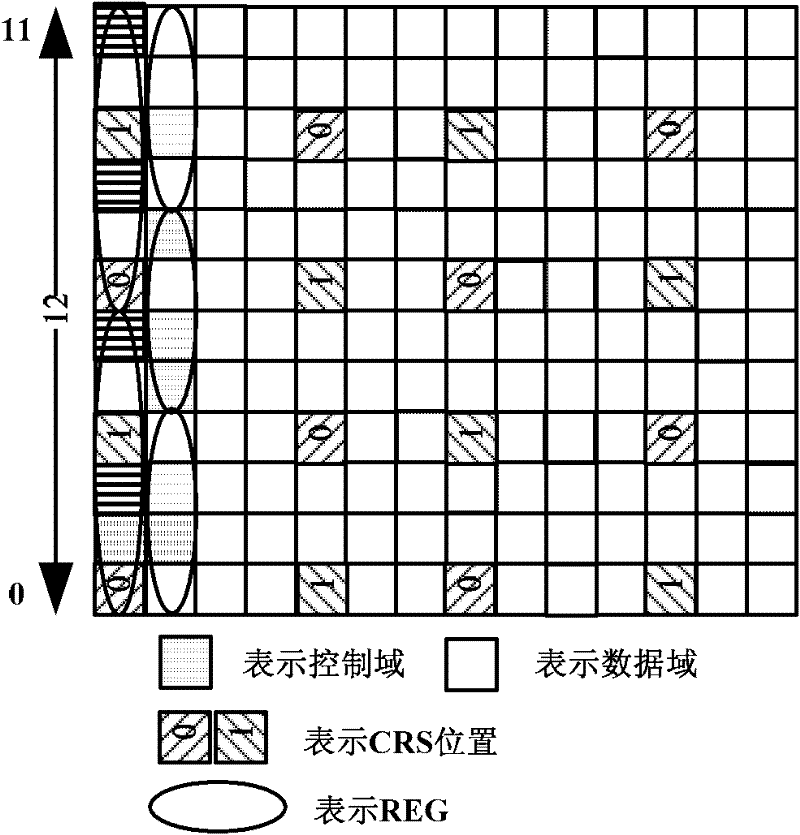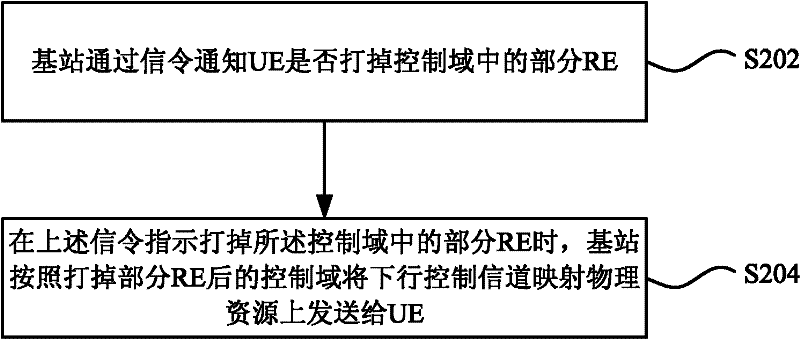Transmitting method and device for downlink control channel
A technology of control channel and transmission method, which is applied in the direction of transmission path sub-channel allocation, signaling allocation, multi-frequency code system, etc., can solve problems such as downlink control information decoding failure, and achieve the effect of improving demodulation performance
- Summary
- Abstract
- Description
- Claims
- Application Information
AI Technical Summary
Problems solved by technology
Method used
Image
Examples
Embodiment 1
[0057] In this embodiment, the method for base station mapping downlink control information mainly includes the following steps:
[0058] Step S02, the base station sends a signaling b1, the above-mentioned signaling indicates whether the deletion of the RE is allowed, 1 indicates that the deletion is allowed, and 0 indicates that the deletion is not allowed. In this embodiment, b1=1;
[0059] In this embodiment, the base station respectively indicates the frequency domain position and the time domain position of the RE that the UE is knocked out, specifically as follows:
[0060] Indicate the frequency domain position of the deleted RE (indicated by two REs as a group) in bitmap mode; the time domain position is configured as the first OFDM symbol in the subframe by signaling, or as the first OFDM symbol in the subframe and the second OFDM symbol, or, the penultimate OFDM symbol in the first slot of the subframe, the first OFDM symbol in the second slot of the subframe, and t...
Embodiment 2
[0073] In this embodiment, the method for base station mapping downlink control information mainly includes the following steps:
[0074] Step S02, the base station sends a signaling b1=1, the above-mentioned signaling indicates whether the RE is allowed to be deleted, 1 indicates that the RE is allowed to be deleted, and 0 indicates that the RE is not allowed to be deleted;
[0075] In this embodiment, the base station respectively indicates the frequency domain position and the time domain position of the RE that the UE is knocked out, specifically as follows:
[0076] The frequency domain position of the deleted RE is indicated by the bitmap method to indicate the corresponding RE, wherein the bitmap indication method excludes the RE where the CRS of the cell is located (two REs are used as a group to indicate); the time domain position is configured as sub- The first OFDM symbol in the frame, or the first and second OFDM symbols in the subframe, or, the third last OFDM sym...
Embodiment 3
[0090] In this embodiment, for a 2-antenna or 4-antenna scenario, a downlink control signaling mapping method that can further reduce signaling overhead is provided. In this embodiment, the method mainly includes the following steps:
[0091] Step S02, the base station sends a signaling b1=1, the above-mentioned signaling indicates whether the RE is allowed to be deleted, 1 indicates that the RE is allowed to be deleted, and 0 indicates that the RE is not allowed to be deleted;
[0092] In this embodiment, the frequency domain position of the deleted RE indicates the corresponding RE in bitmap mode (indicating 4 REs as a group); the time domain position is configured as the first OFDM symbol in the subframe through signaling, Either the first and second OFDM symbols in the subframe, or, the penultimate OFDM symbol in the first slot of the subframe, the first OFDM symbol in the second slot of the subframe, and the second OFDM symbol in the second slot of the subframe The time-d...
PUM
 Login to View More
Login to View More Abstract
Description
Claims
Application Information
 Login to View More
Login to View More - R&D
- Intellectual Property
- Life Sciences
- Materials
- Tech Scout
- Unparalleled Data Quality
- Higher Quality Content
- 60% Fewer Hallucinations
Browse by: Latest US Patents, China's latest patents, Technical Efficacy Thesaurus, Application Domain, Technology Topic, Popular Technical Reports.
© 2025 PatSnap. All rights reserved.Legal|Privacy policy|Modern Slavery Act Transparency Statement|Sitemap|About US| Contact US: help@patsnap.com



